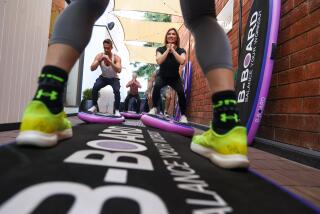Quietly, Epoxy Boards Make Inroads
- Share via
A quiet revolution in the making of epoxy surfboards has been taking shape, and Rockin’ Fig supports the evolution.
Most modern surfboards are shaped from polyurethane foam blanks, wrapped in fiberglass cloth and sealed with polyester resin. Epoxy boards use a super-light Styrofoam core and the same fiberglass cloth but are sealed with a super-hard epoxy resin.
A lot of people seem to like them, and they’re gaining in popularity. But conventional boards still outsell epoxies, 4 to 1.
Part of the reason for that is epoxy boards cost about $100 more than conventional boards, and many surfers are aware only of the first-generation epoxies, which had their drawbacks.
Fig, why are people buying the new ones? They worth the extra money?
They’re really light, they have a good strength factor and are more buoyant in the water than conventional boards, especially when you hit the white water -- they kinda just go whooooosh.
One thing about epoxy boards, however, is they’re susceptible to heat. Surfers who leave them in a parked car where interior temps can soar can soften the blank and cause the board to delaminate.
Javier Huarcaya-Pro, a 34-year-old Peruvian surfer now living in Oceanside, laminates epoxy blanks for dozens of shapers and surf shops. Already, epoxy boards are popular in Australia, Europe and South America, he said last week during an interview at the Action Sports Retailer trade show in San Diego.
For the generally small Southern California surf, light and maneuverable surfboards are the ticket. But the lighter you go, the greater chance for the polyurethane boards to dent, ding or snap in two. This is where paying extra for the latest epoxy boards can actually save you money in the long run. And for heavy-set surfers who are hard on boards and need flotation, the epoxies are tougher and more buoyant than their super-light polyurethane counterparts.
Early generation epoxy boards, Huarcaya-Pro said, were shaped from Styrofoam blanks, covered with fiberglass cloth and sealed with epoxy resin. But the foam was open-celled. When dinged, the blank would soak up water like a sponge and take a week to dry before the ding could be repaired, a definite minus when compared to polyurethane cores, which dry in a day.
Now, however, Huarcaya-Pro uses lighter and stronger extruded Styrofoam, similar to that used in Styrofoam coffee cups but with a wooden stringer down the middle for strength. He then bakes them in large ovens at 134 degrees for nearly four hours.
The result is something much different than earlier epoxy surfboards, which weren’t baked, didn’t have stringers and used the water-sucking Styrofoam.
Huarcaya-Pro acknowledges the misunderstandings of epoxy boards but thinks the new models will convert the cynics. He should know. He has a bachelor’s in industrial engineering from the University of Lima, and his thesis was on the epoxy surfboard.
“The extruded Styrofoam is a denser, closed cell than the earlier blanks,” Huarcaya-Pro explained. “Unlike the earlier boards, the new one’s will not fill with water and they’re stronger. One more thing, they’re recyclable.”
Huarcaya-Pro and his Styrofoam blank supplier, Pedro Vasquez, owner of SVF Co. in Oceanside, said that Dow Chemical, which makes the new blank, has developed a way to reuse excess foam and old blanks. They can be ground up into pellets for making new blanks. Also, any excess foam can be glued together to make a whole board.
“Regular boards using polyester resin are OK,” Huarcaya-Pro said. “But that’s the technology of the ‘60s. These epoxies are finally fitting in with the environmental ‘90s.”
More to Read
Inside the business of entertainment
The Wide Shot brings you news, analysis and insights on everything from streaming wars to production — and what it all means for the future.
You may occasionally receive promotional content from the Los Angeles Times.










